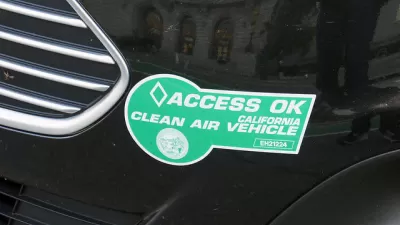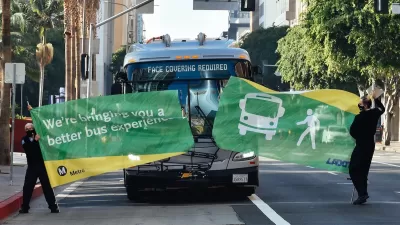The 110 High Occupancy Toll Lanes, conversions of carpool lanes, appear to be a victim of their own success, writes LA Times transportation reporter Laura J. Nelson. An economist would say the solution is to raise the maximum per-mile toll. Or is it?
"So many drivers now steer into the Harbor Freeway's northbound toll lanes to escape morning traffic jams that the paid route is slowing down too," writes Los Angeles Times transportation reporter Laura Nelson. "Over the course of a year, even as the per-mile toll crept toward the maximum, traffic in the paid lanes increased by almost 20% and speeds began to slow."
Metro's algorithm modifies the per-mile toll as frequently as every five minutes, based on how many cars are using the lanes. Tolls range from 25 cents to $1.40 a mile, for a maximum one-way price of $15.40 along the 11-mile route.
Would raising the $1.40 maximum per-mile toll alleviate the problem? Nelson makes a strong case that the toll schedule is irrelevant during peak hours.
But drivers who don't pay tolls from their own wallets have made it more difficult for Metro to influence demand through prices, said Kathleen McCune, Metro's congestion reduction director. Contractors, lawyers and consultants who bill clients for the toll will pay the price, no matter how high. "It could go up to $2,000 a mile and it wouldn't matter to them," she said.
The experts at Brookings take a different perspective.
"The fact that the speeds are getting low suggests prices aren't high enough," said Clifford Winston, a Brookings Institute economist who focuses on transportation policy. "There's no such thing as a price ceiling. If tolls went up to $10 per mile, I'm sure it would have an effect."
This correspondent sides with Brookings. While the toll lanes opened in November 2012, the toll schedule was determined three years earlier, as our July 2009 post indicates. How many transit systems haven't raised their fares six years?
Rather than just looking at the problem of oversubscription of the toll lanes, it's important to put the current situation into perspective. Two years ago Nelson wrote of just the opposite problem (posted here): undersubscription.
Hat tip to Len Conly of Sierra Club Chapter Transportation Chairs listserv.
FULL STORY: MTA's toll-lane project may be a victim of its own success

Alabama: Trump Terminates Settlements for Black Communities Harmed By Raw Sewage
Trump deemed the landmark civil rights agreement “illegal DEI and environmental justice policy.”

Study: Maui’s Plan to Convert Vacation Rentals to Long-Term Housing Could Cause Nearly $1 Billion Economic Loss
The plan would reduce visitor accommodation by 25% resulting in 1,900 jobs lost.

Planetizen Federal Action Tracker
A weekly monitor of how Trump’s orders and actions are impacting planners and planning in America.

Wind Energy on the Rise Despite Federal Policy Reversal
The Trump administration is revoking federal support for renewable energy, but demand for new projects continues unabated.

Passengers Flock to Caltrain After Electrification
The new electric trains are running faster and more reliably, leading to strong ridership growth on the Bay Area rail system.

Texas Churches Rally Behind ‘Yes in God’s Back Yard’ Legislation
Religious leaders want the state to reduce zoning regulations to streamline leasing church-owned land to housing developers.
Urban Design for Planners 1: Software Tools
This six-course series explores essential urban design concepts using open source software and equips planners with the tools they need to participate fully in the urban design process.
Planning for Universal Design
Learn the tools for implementing Universal Design in planning regulations.
Caltrans
Smith Gee Studio
Institute for Housing and Urban Development Studies (IHS)
City of Grandview
Harvard GSD Executive Education
Toledo-Lucas County Plan Commissions
Salt Lake City
NYU Wagner Graduate School of Public Service




























